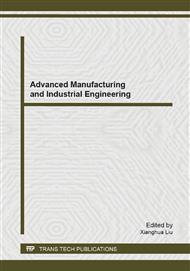[1]
T. Pham, M. Brandl, and D. Beck, Fuzzy declustering-based vector quantization, Pattern Recognition, vol. 42, no. 11, p.2570–2577, (2009).
DOI: 10.1016/j.patcog.2009.03.031
Google Scholar
[2]
K. Tasdemir, Vector quantization based approximate spectral clustering of large datasets, Pattern Recognition, vol. 45, no. 8, p.3034–3044, (2012).
DOI: 10.1016/j.patcog.2012.02.012
Google Scholar
[3]
H. J´egou, M. Douze, and C. Schmid, Improving bag-of-features for large scale image search, International Journal of Computer Vision, vol. 87, no. 3, p.316–336, (2010).
DOI: 10.1007/s11263-009-0285-2
Google Scholar
[4]
Y. -G. Jiang, C. -W. Ngo, and J. Yang, Towards optimal bag-of-features for object categorization and semantic video retrieval, 2007, p.494– 501, cited By (since 1996)99.
DOI: 10.1145/1282280.1282352
Google Scholar
[5]
J. Lai and Y. -C. Liaw, A novel encoding algorithm for vector quantization using transformed codebook, Pattern Recognition, vol. 42, no. 11, p.3065–3070, (2009).
DOI: 10.1016/j.patcog.2009.02.001
Google Scholar
[6]
Z. Lian, A. Godil, X. Sun, and J. Xiao, Cm-bof: visual similarity-based 3d shape retrieval using clock matching and bag-of-features, Machine Vision and Applications, p.1–20, (2013).
DOI: 10.1007/s00138-013-0501-5
Google Scholar
[7]
P. Sprechmann and G. Sapiro, Dictionary learning and sparse coding for unsupervised clustering, 2010, p.2042–(2045).
DOI: 10.21236/ada513140
Google Scholar
[8]
G. Yu, W. Russell, R. Schwartz, and J. Makhoul, Discriminant analysis and supervised vector quantization for continuous speech recognition, vol. 2, 1990, p.681–688.
DOI: 10.1109/icassp.1990.115850
Google Scholar
[9]
Z. Rached, F. Alajaji, and L. Campbell, The kullback-leibler divergence rate between markov sources, IEEE Transactions on Information Theory, vol. 50, no. 5, p.917–921, (2004).
DOI: 10.1109/tit.2004.826687
Google Scholar
[10]
S. Park and M. Shin, Kullback-leibler information of a censored variable and its applications, Statistics, (2013).
DOI: 10.1080/02331888.2013.800070
Google Scholar
[11]
J. J. -Y. Wang, H. Bensmail, and X. Gao, Joint learning and weighting of visual vocabulary for bag-of-feature based tissue classification, Pattern Recognition, vol. 46, no. 12, p.3249–3255, (2013).
DOI: 10.1016/j.patcog.2013.05.001
Google Scholar
[12]
D. Taniar and W. Rahayu, A taxonomy for nearest neighbour queries in spatial databases, Journal of Computer and System Sciences, vol. 79, no. 7, p.1017–1039, (2013).
DOI: 10.1016/j.jcss.2013.01.017
Google Scholar
[13]
S. Lazebnik, C. Schmid, and J. Ponce, Beyond bags of features: Spatial pyramid matching for recognizing natural scene categories, vol. 2, 2006, p.2169–2178.
DOI: 10.1109/cvpr.2006.68
Google Scholar
[14]
J. Xu and H. Liu, Web user clustering analysis based on kmeans algorithm, vol. 2, (2010).
Google Scholar


